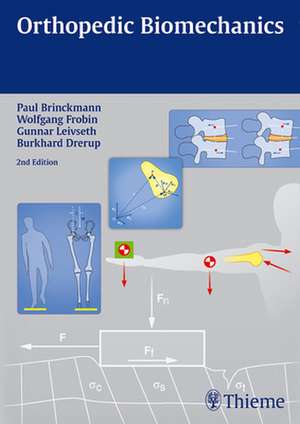Orthopedic Biomechanics
Autor Paul Brinckmann, Wolfgang Frobin, Gunnar Leivseth, Burkhard Drerupen Limba Engleză Paperback – 18 aug 2015
Preț: 516.03 lei
Preț vechi: 610.27 lei
-15% Nou
Puncte Express: 774
Preț estimativ în valută:
98.75€ • 105.59$ • 82.33£
98.75€ • 105.59$ • 82.33£
Carte indisponibilă temporar
Doresc să fiu notificat când acest titlu va fi disponibil:
Se trimite...
Preluare comenzi: 021 569.72.76
Specificații
ISBN-13: 9783131768223
ISBN-10: 3131768223
Pagini: 496
Ilustrații: 290 Abbildungen
Dimensiuni: 176 x 241 x 26 mm
Greutate: 1.04 kg
Ediția:2nd edition
Editura: MM – Thieme
ISBN-10: 3131768223
Pagini: 496
Ilustrații: 290 Abbildungen
Dimensiuni: 176 x 241 x 26 mm
Greutate: 1.04 kg
Ediția:2nd edition
Editura: MM – Thieme
Textul de pe ultima copertă
Orthopedic Biomechanics sheds light on an important and interesting discipline at the interface between medical and natural sciences. Understanding the effects of mechanical influences on the human body is the first step toward developing innovative treatment and rehabilitation concepts for orthopedic disorders. This book provides valuable information on the forces acting on muscles, tendons, and bones.
Beginning with the step-by-step fundamentals of physics and mechanics, it goes on to cover the function and loading of joints, movement in two- and three-dimensions, and the properties of biological tissues. This book explains the practical importance of biomechanics, including special chapters addressing the mechanical causes of disk prolapse, load on the spine in sitting and standing positions, and the correlation between mechanical loading and bone density.
Key Features:
Beginning with the step-by-step fundamentals of physics and mechanics, it goes on to cover the function and loading of joints, movement in two- and three-dimensions, and the properties of biological tissues. This book explains the practical importance of biomechanics, including special chapters addressing the mechanical causes of disk prolapse, load on the spine in sitting and standing positions, and the correlation between mechanical loading and bone density.
Key Features:
- Limited use of complex vector equations while providing in-depth treatment analysis
- Exquisitely illustrated, detailed descriptions of the mechanical aspects of every major joint in the body: hip, shoulder, knee, and lumbar spine
- Extensive references for further information
- Valuable appendixes describing the interaction between mechanical and biological functions as well as mathematical tools necessary to understand technically demanding concepts
Cuprins
Part I Mechanics: Some Basics 1 Basic Concepts from Physics and Mechanics 2 Mechanical Properties of Solid Materials 3 Deformation and Strength of Structures Part II Mathematics: Some Basics 4 Vector Algebra 5 Matrix Notation 6 Translation and Rotation in a Plane 7 Mathematical Description of Translation and Rotation in Three-Dimensional Space Part III Mechanical Aspects of the Human Locomotor System 8 Mechanical Properties of Bone and Cartilage 9 Structure and Function of Skeletal Muscle 10 Mechanical Aspects of Skin 11 Dimensions, Mass, Location of the Center of Mass, and Moment of Inertia of the Segments of the Human Body 12 Determination of Joint Load in a Model Calculation 13 Mechanical Aspects of the Hip Joint 14 Mechanical Aspects of the Knee Joint 15 Mechanical Aspects of the Lumbar Spine 16 Mechanical Aspects of the Shoulder 17 Biomechanics of the Foot 18 Gait Part IV Solved Problems 19 Solved Problems
